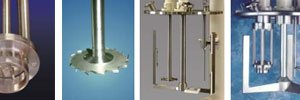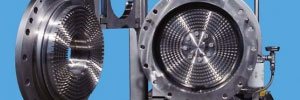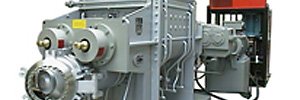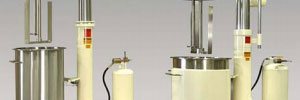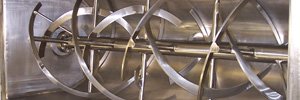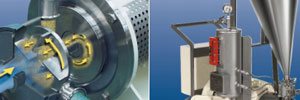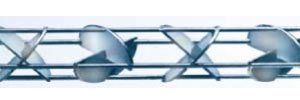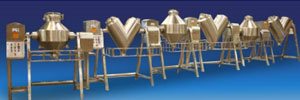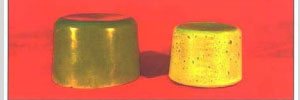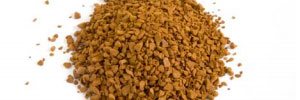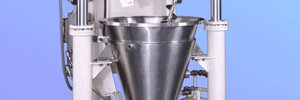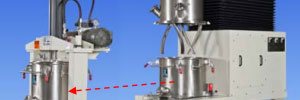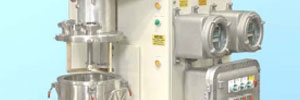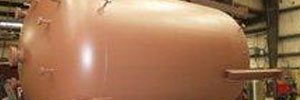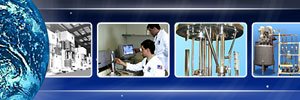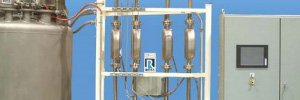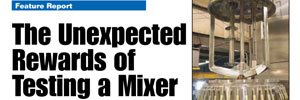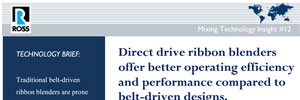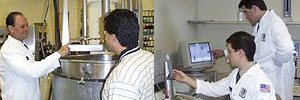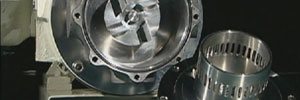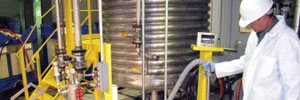Mixing Technology Insights
Mixing Technology Insights offer a brief look into ROSS' products, process expertise and market strengths. The reports delve into how the equipment can be used to improve your process and to add to your bottom line. ROSS strives to provide its customers with up to date information covering new technology in the industrial mixing and blending industry.
Select a specific product, process or market to view a list of related Insights:
Select Product
Select Process
Select Industry
- Pesticide Gel Production in a ROSS VersaMix Triple-Shaft Mixer
Herbicides and insecticides in gel form enable easy, accurate and controlled application for increased efficacy and safety. Compared to traditional pesticides that are sprayed or sprinkled, gel formulations are smeared onto targeted surfaces which reduces the risk of chemical runoff and contamination. - Recommended Mixing Equipment for Polyvinyl Alcohol Solutions
Polyvinyl alcohol (PVOH, also referred to as PVA) is a versatile polymer that plays multiple roles in the manufacture of adhesives, sealants, cosmetics, paper, textiles and many other products. - Recommended Mixing Equipment for Catalytic Slurries
Catalytic slurries consisting of solid catalysts and support materials suspended in a liquid medium are commonly prepared in batch tanks agitated by low-speed mixers such as propellers, anchor paddles and pitched blade impellers. These devices can sometimes suffer from long cycle times and inadequate dispersion especially in large batches. - Recommended Mixing Equipment for Metal Soap Dispersions
Metal soaps such as calcium stearate and zinc stearate are available in the form of a powder or a dispersion containing high percent solids. - Recommended Mixing Equipment for Clay Dispersions
When suspended in liquid, certain clays provide bonding, plasticizing, thickening or suspending properties. - Dissolve solids rapidly.
Consider high-speed sub-surface solids injection for demanding and high-volume dissolution requirements.. - Benefits of ultra-high shear mixing batch mixing and homogenization in the chemical industry
Consider an ultra-high shear rotor/stator mixer for your process. Compared to other batch style mixers including high speed dispersers, traditional rotor/stator mixers and immersion mills, an ultrahigh shear mixer delivers more superior particle or droplet size reduction.. - Upgrade your colloid milling operation
New ultra-high shear mixers offer improved performance and efficiency over traditional colloid mills. Advantages include higher throughput, greater particle size reduction, easier cleaning and lower capital cost. - Preparing wet granulations in a planetary mixer
Planetary mixers are ideal for wet granulation processes. Advantages include "one-pot" processing, high uniformity and yield, predictable performance, and ease of cleaning. - Mixers for continuous dilution
processes
Static mixers and rotor/stator mixers are utilized for truly continuous in-line dilution of concentrated solutions. Advantages include high throughput, low space requirement, easy installation, performance predictability and low maintenance.. - Preparing for a mixing trial.
Simulation trials are useful experiments that help identify the right mixer for a specific application and predict machine performance. This bulletin discusses some preparation ideas for a smooth and productive mixer testing. - Reduce foaming and air
entrapment during mixing.
Foaming and air entrapment are common phenomena encountered in many mixing processes. Different applications call for different solutions, including addition of chemical defoamers, mixing under vacuum and high-speed sub-surface powder induction.. - Mixing dilatant materials
Dilatant materials pose a unique mixing challenge due to their very nature: the greater the shear forces applied to the material, the more resistance is encountered. Heavy-duty, high-torque double planetary mixers operated under comparatively low speeds are ideal for processing shear-thickening mixtures. - Preparing wet granulations in a planetary mixer
Planetary mixers are ideal for wet granulation processes. Advantages include "one-pot" processing, high uniformity and yield, predictable performance, and ease of cleaning. - Inline mixing of gases and liquids
Efficient mixing of gases and liquids is a critical step in many chemical and biological process technologies. Static mixers and inline rotor/stator mixers are typically used in gas-liquid applications where high intensity mixing, short contact time and/or continuous processing are required. - Control system options for explosion-proof mixers
Multiple options are available for explosion-proof controls of mixing systems installed in hazardous environments. To select the best and most cost-effective controls solution, it helps to work with an experienced control designer who knows the details of your process as well as the mixing system and auxiliary equipment involved. - Mixing abrasive pastes and
slurries
Dispersion of abrasive solids into liquid can be accomplished in single-shaft, multi-shaft or planetary mixers, depending on product rheology and degree of abrasion. This bulletin discusses some strategies for combating abrasive wear in these types of mixers. - Scale-up of batch mixers
Successful scale-up of specialty mixing equipment often relies less on straightforward formulas and more on empirical data and experience. This bulletin discusses some practical tips and considerations useful in the scale up of batch mixing operations.. - Multi-agitator mixer/reactors
Multi-agitator mixers are ideal for reaction processes that require intense mixing, high speed dissolution, emulsification, deagglomeration or heating/cooling of viscous liquids. - Select a powder induction mixer that can serve multiple mix tanks of virtually any size.
An inline rotor/stator mixer equipped for powder induction offers flexibility, capability and portability to serve multiple mix vessels of virtually any size. Its straightforward operation and convenience further maximize equipment utility while simplifying material handling. - Ribbon blenders are ideal for coating and mixing processes.
Solid-solid mixing sometimes involves powders that need to be uniformly coated with smaller particles of a different component. The ingredient that is coated onto the bulk material is typically a very small percentage of the batch, thus requiring thorough and uniform blending. Ribbon blenders are proven to be highly effective for these coating and mixing operations. - Improve emulsion stability through ultra-high shear mixing.
The droplet size distribution of an emulsion largely dictates its stability. Fine droplet sizes are produced by applying sufficient shear, often through the use of conventional rotor/stator mixers. Today, ultra-high shear rotor/stator designs are available which can improve emulsion stability of certain formulations. - High speed mixing: saw-tooth dispersers vs. rotor/stator mixers
The saw-tooth disperser and rotor/stator mixer are two of the most widely used high speed mixers yet many are unaware of the differences in their utility and operating capacities. Knowing the unique attributes of these devices is important in mixer selection and process optimization. - Eliminate “fish eyes” in your mix.
Inefficient mixing can lead to agglomerates and “fish eyes” which are difficult to disperse once formed. Using a high shear mixer equipped for powder induction helps prevent the formation of agglomerates, maximizes yield and cuts cycle time. - Use of powder induction mixing technology can significantly reduce raw material costs.
An efficient mixing system with powder induction capability enables manufacturers to optimize raw material costs in two ways: by allowing them to source and handle ingredients in dry form rather than the more expensive liquid form; and by maximizing yield of all powder components. - Inline high shear mixers instantly boost batch production without disturbing existing equipment.
Many batch mixing processes can be optimized with the addition of an inline rotor/stator mixer. The supplemental agitation and shear provided by an inline mixer boosts production by reducing cycle time. Multiple batch tanks can be serviced by a single inline mixer and benefit from its pumping capabilities. Another practical advantage to an inline mixer is that it is easily installed without disturbing pre-existing equipment. - Run your rotor/stator mixer at maximum speed to optimize emulsification & particle size reduction.
Generally, the maximum speed setting of a rotor/stator mixer provides the optimal mixing results in terms of particle or droplet size reduction. Once an equilibrium size distribution is reached, subsequent passes through the rotor/stator give diminishing returns. For applications that are processed at the maximum speed of a traditional rotor/stator mixer but still fall short of the desired particle or droplet size, a move to higher energy devices, such as ultra-high shear mixers, is recommended. - Ultra-high shear mixers increase overall throughput and efficiency of homogenization processes
Ultra-high shear rotor/stator systems speed up cycle time by reducing the number of passes required through a high pressure homogenizer, an inherently low-throughput, high-energy device. Since homogenizers are also generally maintenance-intensive, an efficient ‘pre-mixer’ generates significant savings in the overall cost of production. In certain applications, ultra-high shear mixers even offer a viable alternative to homogenizers. - Apply high speed powder
induction to eliminate dusting
in the mixing area
The release of airborne particles into the plant atmosphere when powders are added to a mix vessel leads to significant maintenance costs and safety concerns. A high speed induction device can eliminate dusting and accelerate both production and process changeover.

